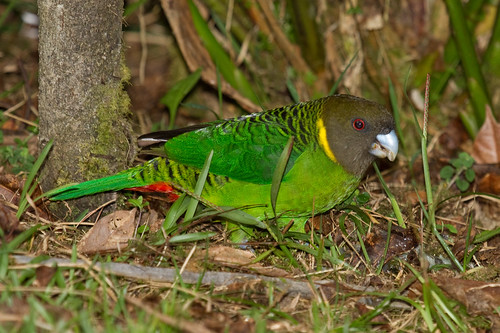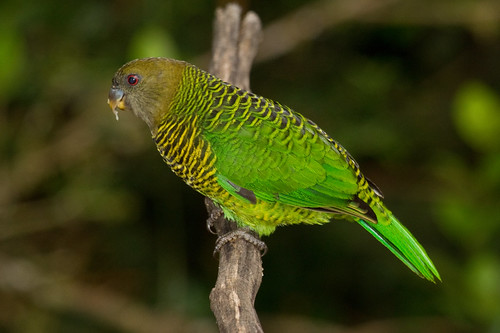 Image by Marcel Holyoak - Brehm's Tiger-parrot (Psittacella brehmii) male Recently released genetic research from CSIRO and New Mexico State University in the US is helping scientists better understand how Australian birds evolved. The researchers found that the tiger-parrots of New Guinea's rainforests -- named for their striped or barred plumage -- are not, as has been widely accepted, closely related either to a group of rosella-like parrots found in Australia and Oceania, nor a similar group found in Asia and Africa.
Image by Marcel Holyoak - Brehm's Tiger-parrot (Psittacella brehmii) male Recently released genetic research from CSIRO and New Mexico State University in the US is helping scientists better understand how Australian birds evolved. The researchers found that the tiger-parrots of New Guinea's rainforests -- named for their striped or barred plumage -- are not, as has been widely accepted, closely related either to a group of rosella-like parrots found in Australia and Oceania, nor a similar group found in Asia and Africa.
In the latest edition of Molecular Phylogenetics and Evolution, they report that tiger-parrots instead occupy their own perch on the parrot evolutionary tree.
 Dr Leo Joseph, Director of CSIRO's Australian National Wildlife Collection, with some of the Collection's specimens of tiger-parrots. The researchers found that the tiger-parrots of New Guinea's rainforests -- named for their striped or barred plumage - are not, as has been widely accepted, closely related either to a group of rosella-like parrots found in Australia and Oceania, nor a similar group found in Asia and Africa. (Credit: CSIRO)
Dr Leo Joseph, Director of CSIRO's Australian National Wildlife Collection, with some of the Collection's specimens of tiger-parrots. The researchers found that the tiger-parrots of New Guinea's rainforests -- named for their striped or barred plumage - are not, as has been widely accepted, closely related either to a group of rosella-like parrots found in Australia and Oceania, nor a similar group found in Asia and Africa. (Credit: CSIRO)
Co-author, the Director of CSIRO's Australian National Wildlife Collection (ANWC) Dr Leo Joseph, said the findings will help improve our understanding of how parrots have evolved.
"This research on tiger-parrots -- and some other enigmatic Australian parrots such as the little-known Night Parrot of inland Australian deserts -- sheds light on the bigger picture of parrot evolution for Australia and New Guinea," Dr Joseph said.
"It has shown for the first time, for example, that tiger-parrots represent a very early branch of the parrot evolutionary tree in Australia and New Guinea.
"The research team's quest has been to understand the true places of parrots such as the Night Parrot and the tiger-parrots in the ecological and evolutionary history of parrots across the Australian continent.
"During our research on these oddball parrots of Australia and New Guinea, we affirmed that the Australian parrots are far from one cohesive group. They appear, instead, to be made up of about five different main branches of the parrot evolutionary tree," Dr Joseph said.
"We have shown that the New Guinea tiger-parrots aren't rosella-like parrots and that their resemblance in some aspects of their appearance to rosellas probably indicates some plumage characters that have been part of the evolution of parrots of Australia and New Guinea for a long time.
"We also showed, because we included so many other parrots, that they aren't even part of the Asian and African assemblage with which they have even more often been associated.
"In fact, it seems they are something nobody had really appreciated -- a very early branch of the Australian and New Guinean evolutionary tree of parrots," he said.
Dr Joseph said that by being able to accurately trace who is related to whom in a group of organisms, scientists can better understand how the evolutionary process affects diversity in the living world.
 Image by Marcel Holyoak - Brehm's Tiger-parrot (Psittacella brehmii) male
Image by Marcel Holyoak - Brehm's Tiger-parrot (Psittacella brehmii) male
The Australian National Wildlife Collection (ANWC) -- home to more than 200 000 scientific specimens -- supported the research by providing the genetic material that formed the bases of the study.
The paper's other co-authors are: Dr Alicia Toon from CSIRO and, Dr Tim Wright and PhD student Erin Schirtzinger from New Mexico State University.